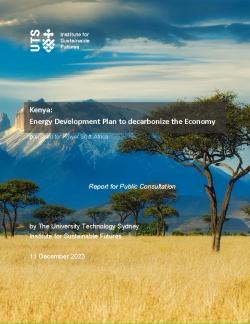The energy report ‘Kenya: Energy Development Plan to decarbonise the Economy’ is the preliminary result of a joint research by Power Shift Africa and the University of Technology Sydney – Institute for Sustainable Futures conducted between January and November 2023.
The task was to develop comprehensive energy scenarios for Kenya which challenges the current government and private sector plan and provides new scientific input for future policies.
A focus of this work lies on the development of a 100% Renewable Energy Pathways to provide data for future National Determined Contribution (NDC) report for the UNFCCC.
The 100% Renewable Energy pathways are developed as robust, reliable, and cost-effective energy plans and based on GIS based renewable energy potential analysis for solar and wind energy, hourly simulation to determine a high-level analysis of the required storage and grid expansion requirements.
The energy pathways aim to phase-out energy-related CO2 emissions as fast as possible while implementing fast and ambitious energy access programs.
The energy demand analysis is based on the following assumptions:
1. Economic growth to facilitate high enough to develop towards a middle-income country
2. Increase energy demand for services and industries
3. Increased decarbonised transport sector
4. Access to reliable and affordable energy services for all households to achieve OECD household standards by 2050.
This report provides a detailed technical documentation of the energy scenario development and is part of the global ‘One Earth Climate Model research program under leadership of the University of Technology Sydney – Institute for Sustainable Futures. Further details about the One Earth Climate Model are available at www.uts.edu.au/OECM
PSA’s mission is to mobilise climate action in Africa, amplify African voices through increased visibility in media and public communications, and leveraging this voice internationally. As part of our work, PSA is helping to build dedicated platforms of African civil society organisations, technical experts and high-level leadership that will engage collectively to ensure a transformative, Africa-led efforts to accelerate and scale-up the harnessing of the continent’s huge renewable energy potential. We seek to promote and support Africa to meet its short and long-term targets to achieve the 1.5C target through a just transition to 100% renewable energy.
This report is for PUBLIC CONSULTATION – feedback and comments are welcome.
Please contact:
A/Prof. Dr. Sven Teske / UTS-ISF in Australia: Sven.teske@uts.edu.au or
Amos Wemanya of Power Shift Africa in Kenya: AWemanya@powershiftafrica.org
Download the report
Background
This report focuses on the development of a 100% Renewable Energy Pathway for Kenya. Here, the 100% Renewable Energy pathways is constructed with the aim to be robust and to proof the technical and financial feasibility. In addition, the 100% Renewable Energy pathways will be a clear demonstration of security of supply for Kenya’s industry, transport and residential sectors.
The scenarios for the energy pathways do not claim to predict the future but provide a useful tool with which to describe and compare potential development pathways from the broad range of possible ‘futures.’ The Kenya1.5 °C (T-1.5°C) scenario is designed to calculate the efforts and actions required to achieve the ambitious objective of a 100% renewable energy system and to illustrate the options available to change the Kenya’s energy supply system into a truly sustainable one. It may serve as a reliable basis for further analyses of the possible ideas and actions required to implement pathways to achieve the desired results.
100% renewable energy scenarios for electricity generation, energy demand, energy supply, and transport are included. The investments required to achieve these scenarios and the policies that will enable them are described for the specific scenarios.
Finally, the report includes simulations of the national grid capacity required now and, in the future, and the necessary linkages between different parts of the country’s power grid. The simulations support the assessment of the grid expansion requirements, the power-trade balance, and the investments required to strengthen the backbone of Kenya’s electricity infrastructure to ensure its reliability and resilience.
In this report, we aim to inform policymakers, researchers, and practitioners of the extent of the intervention required for Kenya to reach its target of 100% renewable energy by 2050. The decade-by-decade scenarios can inform important milestones that will allow further sector-wise energy-related targets to be defined and tracked.

